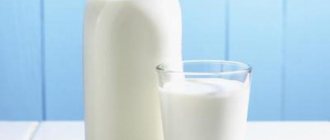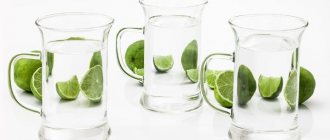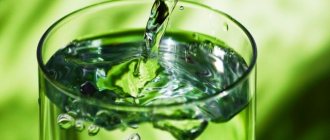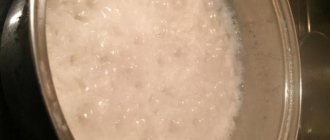What is water-salt balance
Water-salt balance is a certain ratio of salts and liquids in the body. Any imbalance in this system can cause at least poor health or the formation of various diseases.
Water in our body carries nutrients to cells and helps remove toxins and metabolic waste from them.
In this case, the task of salts is to retain some of the water outside the cells. After all, according to doctors, good health depends, among other things, on the fine balance of intercellular and intracellular fluid.
This balance is achieved through several factors:
- drinking enough water daily;
- adding a moderate amount of natural salt to the diet;
- eating a variety of potassium-rich fruits and vegetables.
Preventing fluid accumulation
- Drink at least two liters of water per day.
- Reduce the amount of salt and sugar, or eliminate their consumption altogether. Sugar can be replaced with fruits and natural honey.
- Adhere to a balanced and healthy diet, including fruits, vegetables, cereals, and lactic acid products.
- Eat dried fruits, raisins, nuts, dark chocolate (in small quantities).
- Do not forget that doing physical exercise is useful, and walking in the air speeds up metabolism and leads to more active diuresis.
- Do not use diuretics without a doctor’s prescription, so as not to cause dehydration.
Maintaining the correct drinking regime and reducing foods that retain water in the diet protect the body from many diseases.
Water and salt content
Water is the main element in the human body. However, its content varies and largely depends on gender, age, amount of fat and other factors.
Averages might look like this:
- 55% of water is contained in the female body;
- 65-68% - in men's;
- 70-80% - in the body of newborns.
The water content in the body of older people is the lowest - about 50%.
To maintain these indicators, healthy adults are usually advised to drink 1.5-2 liters of water per day. But this is an average recommendation. The body's individual need for water is calculated using the formula: 10-30 milliliters per kilogram of body weight.
However, indicators can vary significantly depending on climatic conditions, physical activity and human health. Dehydration is usually spoken of when the body's loss of moisture exceeds its intake.
As for salts, that is, electrolytes for our body, each of them has its own role. Among those necessary for the human body are potassium, sodium, magnesium, chlorine, calcium and phosphorus.
Thus, potassium is indispensable for the functioning of the smooth muscles of the heart and digestive tract. Calcium ions are responsible for muscle contraction and proper heart rhythm, and thanks to them, nerve impulses are transmitted. Sodium has similar functions. In addition, he is responsible for stable pressure in the blood vessels.
The functionality of the kidneys is ensured by phosphorus ions, and the stable functioning of the nervous system is ensured by magnesium salts. And the responsibility of chlorine is fluid balance.
“Sodium levels can increase with cardiovascular diseases, but thyroid pathologies lead to a decrease in calcium. The content of salts, electrolytes, as well as fluids, must be adjusted, since the functional state of all our systems and organs, the level of acidity of the body, arterial blood pressure, the conduction of nerve impulses, as well as the ability to restore damaged tissues depend on them. It is very important to maintain a balance of water-salt metabolism, especially now, when all organs and systems must be so adjusted to resist any viruses and infections. Only by having a balance between fluids and electrolytes can we consider ourselves healthy people.”
Alvina Sergeeva
therapist, gastroenterologist, physiotherapist, anti-aging medicine doctor.
In the Altai Republic, weather forecasters predict hot weather in the coming days. You can read about how to behave in hot weather at the link: https://www.fbuz04.ru/index.php/deyatelnost/zdorovyj-obraz-zhizni/kak-sokhranit-svoe-zdorove-v-zharu
Now it is important to be interested in one more question: how much should you drink in the heat and what drinks should you prefer in order to effectively remove thirst and not harm your health?
The human body is approximately 70% water. Water deficiency causes severe stress, which changes hormonal balance, increases blood viscosity and the acidity of body fluids. If at normal air temperatures an adult needs to drink up to 2 liters of liquid per day, then on hot days the volume should be increased by 1.5 - 2 times.
Do not drink too cold drinks or add ice to them. Cold drinks, due to the feeling of freshness, distort our perception of saturation with liquid. In addition, the body heats the too cold liquid that enters it, which is accompanied by the production of excess heat. It turns out to be a vicious circle: you drink, you get temporary relief, which not only does not completely saturate the body, but also causes it to heat up further. In addition, the intake of cold drinks can provoke inflammatory diseases of the nasopharynx.
To retain water in the body, you can use one of the useful methods - eat vegetables, berries, and fruits. The liquid they contain helps retain water in the body. This does not mean that you need to give up water, but it is recommended to drink fruits, vegetables and berries with water.
What can you drink?
Water. This is an absolute leader and there is no need for explanations. Plain water from the tap or in plastic bottles is not suitable for effectively quenching thirst in hot weather. In the heat, a large amount of potassium, sodium, phosphorus and magnesium salts are released from the human body along with sweat. If a person drinks plain water, then the replenishment of minerals does not occur, and the feeling of thirst remains.
It is more beneficial to use well or spring water, the safety (in terms of chemical and bacteriological composition) of which has been confirmed in the laboratory.
Drinking medicinal mineral waters without a doctor’s advice can lead to the appearance of kidney stones due to the increased content of certain microelements in them. It is better to drink table mineral water, but you should not consume it in large quantities either.
Milk. Despite the fact that it is much fattier than water, milk copes with thirst no worse. On a hot day, when there is no particular appetite, milk will not only save you from “drought”, but will also serve as a source of protein. It is worth remembering that milk is still more food for the body than drink. A good alternative to classic milk is plant-based drinks. This is milk made from cereals and nuts.
Fermented milk drinks are another excellent, long-known thirst quencher. In addition, the content of pure cultures of lactic acid bacteria improves digestion, lowers cholesterol and blood sugar levels. Just like milk, fermented milk products are more food than drink.
Natural fruit juice , preferably freshly squeezed and without sugar. The juice contains about 85% water. If the juice is too thick, it needs to be diluted with water.
Tea . It is better to quench your thirst with decaffeinated tea or herbal tea. Whether hot or cold, chamomile or green, tea is great for replenishing fluids and is rich in antioxidants.
Compotes . Especially homemade, prepared without sugar or with very little sugar. The traditional Russian drink is rich in vitamins and quenches thirst well.
Fruit water is a simple drink consisting of drinking water and pieces of fruit, vegetables or herbs.
Kvass. The best thing is to make it yourself with a minimum amount of sugar. Currently, it is almost impossible to find high-quality kvass on sale - more often it is an effervescent carbonated drink made using a synthetic surrogate.
Sports drinks . The electrolytes contained in sports drinks help hydrate the body more effectively. In addition, they will appeal to those who find the water too bland. However, it is worth noting that such drinks contain a lot of carbohydrates. Therefore, it is better to drink them only during training.
What should you not drink?
Sweet soda. Many types of soda contain caffeine, which promotes dehydration, and a lot of sugar, which is harmful to your teeth and figure. If it is impossible to live without magic bubbles, you can drink drinking or sparkling mineral water .
Coffee. In small quantities, coffee containing a lot of caffeine will not harm you (unless there are any contraindications). But more than 2-3 cups a day already carries various risks, including increased blood pressure and dehydration. This is especially dangerous in hot weather.
Hot chocolate. One mug won’t do much harm, but it’s clearly not worth considering cocoa as a way to quench your thirst. One cup of this drink contains more sugar and calories than a can of soda.
Beer, wine and spirits. Drinking any alcohol helps remove fluid from tissues. And the more alcohol you drink, the greater your thirst. We should also pay attention to cocktails like “Rum-Cola”, which combine two main sources of thirst. The solution to the problem is obvious: quit alcohol.
Tea with sugar . Sugar makes tea completely unsuitable for quenching thirst. You can perceive this drink as a dessert, nothing more.
Energy drinks are filled with caffeine, sugar and various chemical additives. Not to mention the harm they cause to the body as a whole, drinking them to replenish your water balance is absolutely pointless.
Milkshakes and milk with additives . There is nothing bad in milk itself, but drinks based on it, which are now plentiful on store shelves, contain large amounts of sugar and flavorings. Vanilla, chocolate, strawberry milk is not at all the same as just milk!
Smoothie . Popular and delicious, fruit smoothies are very tempting, especially on a hot day. But they contain too much fruit pulp (and most often sugar) to really help combat thirst. If the choice falls on them, then, like thick juices, they need to be diluted with water or ice.
Lemonade. In the assortment of cafes and restaurants, especially in the warm season, there are usually several types of lemonade. Just don’t expect that they are healthy and natural. Most likely, the beautiful drink from the picture will be stuffed with sugar, dyes, flavors and other additives. And it won’t quench your thirst, and it will ruin your figure. It is better to choose water with lemon and mint.
And one moment. In hot weather, you often lose your appetite. Therefore, it is especially important to maintain the correct diet so as not to deprive the body of all the substances it needs, including the liquid obtained with food.
The concept of normal water-salt balance
For the normal functioning of all organs and systems, it is equally important how much water and salts enter the body and how much they are excreted. Ideally, these volumes should be balanced.
If a person consumes 2 liters of liquid per day in the form of food and drinks, then on average 1.5 liters will be excreted in the urine, that is, by the kidneys. The remaining volume is excreted through the intestines and lungs.
This ratio must be stable. This is the only way to avoid unpleasant symptoms and dangerous dehydration.
How long does the drug salt last in the blood and urine?
How much salt the drug will leave the body directly depends on the composition of the substance and the time of use. In general, the longer the addiction lasts, the longer the breakdown products of the drug remain in the body. Accordingly, they are easier to identify.
For example, if you smoke mephedrone once, the salt will remain in the body for up to 48 hours. If you use the drug up to three times a week, it will be eliminated in at least 2–5 days.
In various tissues, traces of the substance can be detected both after several hours and several years. So, even if six months have passed since the last use, competent specialists will be able to establish the existence of addiction.
How long does the drug salt last in urine? Everything here is also individual. On average, if you try a euphoretic once, it will remain in the urine for about another week. If you suffer from a bad habit for a long time, harmful substances can be detected in a urine test even after two months.
Causes of imbalance
Disturbances in water-salt balance are not only a lack of salts and water in the body, but also their excess, which manifests itself, for example, in the form of edema. At the same time, dehydration is fraught with thickening of the blood and the formation of blood clots. This risk occurs even when the fluid deficiency is only 20%.
Of course, the content of salts and fluid in the body is not a constant value. It depends, among other things, on the season.
This balance can be “shattered” for other reasons:
- Unbalanced diet (excess carbohydrate foods);
- Improper drinking regime;
- Alcohol abuse;
- Intense physical activity;
- Cardiovascular diseases;
- Disorder in the functioning of the thyroid gland;
- Kidney and liver diseases;
- Hormonal imbalances;
- Diabetes;
- Use of diuretics;
- Toxicosis during pregnancy;
- Premenstrual syndrome;
- Sedentary lifestyle;
- Venous insufficiency;
- Diarrhea and vomiting;
- Increased body temperature.
In addition, there is a hidden reason for the disturbance of water-salt balance in the body. Thus, a detailed analysis of blood biochemistry can show the disorder of individual ions in the blood plasma.
Symptoms of water-salt imbalance
The imbalance develops quite quickly - on average per day. Provided that during this time the body will spend more water than it receives, or vice versa. After all, all chemical processes in our body occur with its direct participation.
There are two forms of imbalance of fluids and salts in the body - dehydration (dehydration) and swelling (overhydration).
Signs of dehydration:
- Coated tongue;
- Bad breath;
- Dry skin;
- Rapid breathing;
- Nausea;
- Pain in joints and muscles;
- Cardiopalmus;
- Weight loss.
Symptoms of overhydration:
- Weakness;
- Vomit;
- Edema;
- Convulsions;
- Arrhythmia;
- Fainting.
Frequent urination, excessive sweating and changed skin color should also alert you. If such symptoms appear, it is better not to postpone a visit to the doctor.
Diagnosis of imbalance
Insufficient water consumption and, as a result, disruption of the water-salt balance can lead to serious disruptions in the functioning of all body systems.
The volume of fluid and salts in the body is assessed using laboratory testing of venous blood. This analysis allows you to give a general assessment of your health. It is recommended to do it after using diuretics, as well as for kidney diseases.
The study, in particular, shows whether the content of potassium, sodium and chlorides, which are involved in metabolic processes, heart activity, conduction of nerve impulses and muscle contraction, is normal.
How exactly an electrolyte imbalance is treated depends on its severity.
Treatment of water-salt imbalance
How to restore water-salt balance? If it is impaired due to loss of fluid, then it is replenished by consuming small portions. In addition, either sodium replenishment solutions or electrolytes sold over the counter are recommended.
IMPORTANT: If symptoms of dehydration are severe in a child, you should immediately seek medical help.
In addition to the use of medications, restoration of water-salt balance is also carried out using a special diet, outpatient treatment and some folk remedies.
Taking medications
Various vitamin and mineral complexes, as well as antihypertensive drugs that affect the water-salt balance, help normalize the volume of fluid and salts in the body.
Traditionally, they are prescribed as a course for a month, after which a break of a couple of weeks is required. If necessary, the results are consolidated with another such course.
Chemical therapy
If there is a lack of salts, for example, in case of poisoning and dysentery, the doctor may prescribe so-called chemical therapy. Essentially, this is the use of saline solutions that restore chemical balance and accumulate water in our body.
And although such compositions for solutions are available in almost any pharmacy, you should not “prescribe” them yourself. The fact is that they need to be taken according to a certain scheme and under strict indications. In addition, you should not use saline solutions if you have kidney failure, diabetes mellitus and some other diseases.
Ambulatory treatment
In particularly difficult cases of water-salt imbalance, a person may require treatment in a hospital.
In such situations, various droppers are used to regulate salts and fluids in the body.
In addition, such patients are prescribed a special diet.
Diet
Following a special diet also helps restore water-salt balance.
For example, a patient may be advised to drink 2-3 liters of clean water per day and at the same time consume at least 7 grams of salt, for example, dissolved in it. Also, a diet to normalize the volume of salts and fluids involves consuming foods rich in potassium, magnesium, selenium, calcium and zinc. These can be dried fruits and nuts.
If a person has heart and vascular diseases, the treatment approach will be different. So, he should not drink more than 100 grams of water at a time, and it should be without added salt.
Restoring water-salt balance using folk remedies
The arsenal of traditional medicine also has means that allow you to establish the water-salt balance. Basically, these are medicinal plants.
So, to maintain the optimal composition of salts and fluids in the body, the following are used:
- Black currant leaves;
- Parsley and celery in the form of a decoction;
- Steamed buckwheat;
- Lemon-garlic infusion.
However, you should not self-medicate, no matter how proven folk recipes are. Before trying any of them, it is best to consult your doctor.
How to remove water from the body
To lose weight, you need to:
- Drinking at least a couple of liters of water per day will help to establish water-salt metabolism, remove water and reduce swelling.
- Reduce the amount of carbonated drinks, coffee, alcohol and tea you drink.
- Avoid overly salted, smoked, pickled and canned foods. Food should contain a minimum of salt, otherwise it will be difficult to remove moisture.
- Add water-removing foods to your daily menu.
- Regularly take a contrast shower and visit the steam room in the sauna or bathhouse. Such procedures help remove water from the body.
- Increase the amount of physical activity - take walks, do exercises, do fitness.
Wearing comfortable, non-pressure shoes and lifting your legs higher than your body while taking a horizontal position (to do this, place a couple of pillows or a rolled-up blanket under your feet) will help remove swelling from the legs, which will ensure the outflow of fluid from the limbs and help remove it.
Recommendations for maintaining water-salt balance
Maintaining chemical balance in your body is not difficult if you follow simple rules of prevention:
- Drink a glass of water on an empty stomach;
- Drink enough water alone or, for example, with a slice of lemon;
- Increase fluid intake during intense physical activity or hot weather;
- Don't be thirsty - carry a bottle of water with you;
- Play sports or at least walk more, since a sedentary lifestyle leads to water-salt imbalance;
- Do not overuse foods containing salt;
- Restore your sleep schedule - go to bed no later than 23-00 and sleep no longer than 8 hours;
- Add a variety of vegetables and fruits to your diet;
- Try to avoid stress.
If you notice symptoms of water-salt imbalance, make an appointment with a specialist. He will determine the cause and prescribe effective treatment.
And the latest research...
New work by Sophie Keeler from the University of Birmingham (UK), published earlier this year, not only measured the volume of urine excreted, but also checked how the functioning of the subjects' kidneys was reflected in blood tests, and also calculated the total amount of water in the body.
In the experiment, the men drank four cups of coffee a day, which is much more than the average coffee drinker drinks. There was no evidence that the subjects were dehydrated compared to those who drank only water.
Although this study was funded by the Institute for Coffee Scientific Information, of which coffee companies are members, it was published in a peer-reviewed scientific journal, and the authors confirm that the Institute had no influence on data collection, analysis or writing of the study.
Thus, even if we notice the need to go to the toilet after a cup of coffee, we should not compare this with the situation when we do not drink at all. Because if you drink a glass of water instead of a cup of tea or coffee, the effect will probably be the same.
About the author: Claudia Hammond writes articles, hosts television shows, and lectures on psychology.
Brief conclusions
- Water-salt balance is a certain ratio of salts and fluids in the body, the violation of which can lead to poor health or the development of various diseases.
- For the normal functioning of all organs and systems, it is equally important how much water and salts enter the body and how much they are excreted.
- Disturbances in water-salt balance are not only a lack of salts and water in the body, but also their excess.
- There are two forms of imbalance of fluids and salts in the body - dehydration (dehydration) and swelling (overhydration).
- Symptoms of dehydration or overhydration should be taken seriously, especially if they occur in children.
- The balance of salts and fluids in the body is restored with the help of a special diet, medications, chemical solutions, and also on an outpatient basis, depending on the severity of the case.
Can you just as easily drink boiled water?
So why do many people think that if they drink tea or coffee, they will have to go to the toilet more often?
As Armstrong's review demonstrated, most researchers give people a pure caffeine water solution rather than the tea or coffee we typically drink at home. Maybe the combination of substances that these drinks contain somehow changes things?
In a rare study where subjects drank nothing but tea for 12 hours, there was no difference in hydration levels between them and people who drank the same amount of regular boiled water.
As for coffee, one study actually found a 41% increase in urine output and increased sodium and potassium excretion. But the participants abstained from caffeine before the study began, so the situation may be different for people accustomed to coffee.
Another study found no difference in hydration between tea and coffee drinkers, so we can't draw a definitive conclusion here either.











